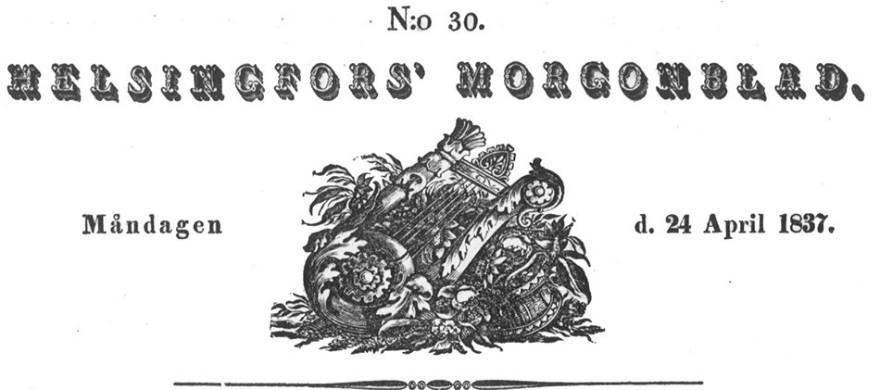The earliest excerpts in Swedish
The great work by Elias Lönnrot, Kalewala, taikka wanhoja Karjalan runoja Suomen kansan muinosista ajoista, was published in 1835 in the Grand Duchy of Finland. The folk poetry singers in the eastern part of the Grand Duchy sang the songs in Finnish, but the administration in the country used Swedish and Russian. Noble families used French and for scientific purposes, the languages that were used were German or Latin.
It is most certain that the discourse during the first decades of the 19th century on Finnish culture, language and the old poems of the Finnish people has been in Swedish. In order to make the people in the bourgeois families in Turku, Helsinki, Oulu and Uusikaarlepyy as well as the universities in the Grand Duchy understand the importance of the discussions, the newspapers had to print examples of the texts in some other language than poetic Finnish.
The first examples of the Kalevala that showed the readers what it was all about were published in Helsingfors Morgonblad in 1835 in the issues 91–93. This was even before the book was available in bookstores. The text was about Väinämöinen’s journey to find a bride and it was Lönnrot himself who translated it into Swedish using the trochaic octameter. Linguist and folklorist E. N. Setälä wrote in the Valvoja’s Kalevalavihko in 1909: “The translation did not, of course, aspire to fill the artistic requirements, but it has, due to its poetic form, been a base for most of the translations of the Kalevala in poetic meter that exist to date”.
Lönnrot did not want to translate the Kalevala to any greater extent, except for the excerpts. The Finnish Literature Society had reserved funding for the Swedish and German translations of the Kalevala. It is possible that the reward of 500 rubels inspired several people to try and translate the text.
The Swedish translation by Erik Alexander Ingman (1810–1858) of the 5th poem in the Kalevala was published in Helsingfors Morgonblad in 1836 in the issues 79–80 and he also translated the 29th poem. J. L. Runeberg produced excerpts of translations in Swedish that were artistically of higher quality than the translations by Lönnrot and Ingman. His translations were published in Helsingfors Morgonblad in the issues 47–49 in 1836 and in the issue 30 in 1837.
N. Setälä quotes in the Kalevalavihko in 1909 the opening words by the editor-in-chief of Helsingfors Morgonblad, J. L. Runeberg, in which Runeberg introduced the cultural background and history that is shared by the Europeans in the same way as Christfried Ganander and Carl Axel Gottlund did in the 1820’s and this has repeatedly been stated in the forewords of translations:
“The editor has not had the chance to read the other poems in the Kalevala, but he thinks that, based on what he has seen, it may most certainly be stated that the Finnish literature has found a treasure in this poetry, which, to its tone and posture as well as its scope and worth, can be compared to the two most wonderful epic master pieces of Greek art. All the virtues, that these possess in grand and definite fullness, can also be found in Finnish poetry and maybe it is even superior to it, if perfection can be surmounted by the grandeur and austere splendour of how nature is described.”
J.L. Runeberg was an accomplished poet and influential cultural persona, but he needed help in the practical translation work. Carl Niclas Keckman (1793–1838) helped him to understand the Finnish language of the Kalevala.
Petja Aarnipuu: “Kalevala sivistysmaan käyntikorttina” – Kalevala maailmalla. Helsinki: SKS. 2012.
Ferenc A. Molnár: “Vanhan Kalevalan 29. runon ensimmäinen ruotsintaja” – Bibliophilos 1982 (41)/4: 118.
